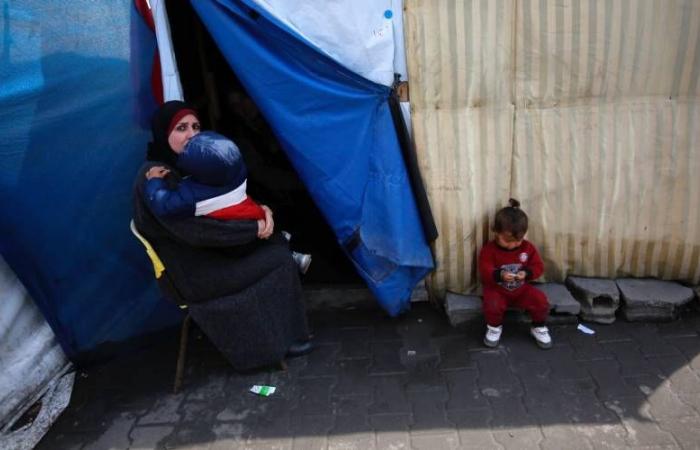There is very little rest for Palestinians in Gaza, even during the holy month of Ramadan, as the conflict in the Gaza Strip continues. The Israeli Security Forces (ISF) continue military operations throughout the Gaza Strip. ISF airstrikes continue in densely populated Rafah, in southern Gaza, where UNRWA estimates that a total of 1.2 million people currently live, the vast majority in formal and informal shelters.
Intense Israeli bombing and ground operations are ongoing. Meanwhile, intense fighting between the ISF and Palestinian armed groups continues in the southeast of Gaza City and in the areas around Al Shifa Hospital in the city. This resulted in more civilian casualties, displacement and destruction of homes and other civilian infrastructure.
The Israeli military operation in and around Al Shifa hospital in Gaza City continued for the third consecutive day. The Director General of the World Health Organization, Tedros Adhanom Ghebreyesus stated on March 18 that: “Hospitals should never be battlefields. The WHO is terribly concerned about the situation at Al Shifa Hospital, which endangers healthcare workers, patients and civilians.” [1]
Analysis of UNOSAT satellite images [2] showed that approximately one-third (or 35 percent) of total structures in the Gaza Strip were damaged or destroyed. The provinces of Gaza and Khan Younis suffered the greatest level of destruction. The hunger [3] is imminent in Gaza, especially among the isolated populations in northern Gaza who have been deprived of humanitarian assistance.
On March 18, the Integrated Food Safety Phase Classification (IPC) partnership released its latest food safety outlook. It concluded that up to 1.1 million people in Gaza face catastrophic levels of food insecurity. The report highlights the rapid deterioration of food security conditions, including a nearly 80 percent increase in the number of people facing the highest classification of food insecurity since December, when the initial assessment was carried out. The increase was triggered by the intensity of hostilities, extremely limited humanitarian access and severe limitations in the provision of basic goods and services. According to UNICEF and UNRWA nutritional assessments carried out in February, rates of acute malnutrition among children in northern Gaza and Rafah nearly doubled in just one month. The IPC report also predicts a worsening of malnutrition rates unless aid increases and reaches the most vulnerable and hard-to-reach populations.
Following the announcement that famine was imminent, there was no significant change in the volume of supplies entering Gaza nor improved access to the north. In the first 20 days of March there was an average of 159 aid trucks per day crossing the Gaza Strip. This remains well below the operational capacity of both border crossings and the target of 500 per day, with challenges in both Karem Abu Salem (Kerem Shalom) and Rafah. Security for managing the crossings has been severely affected due to the deaths of several Palestinian police officers in Israeli airstrikes near the crossings in early February.
As of 16 March, the total number of UNRWA colleagues killed since the outbreak of hostilities was 169, an increase of one.
As of March 20, up to 1.7 million* people (more than 75 percent of the population)** have been displaced in the Gaza Strip, most multiple times.*** Families are forced to move repeatedly in search of of security. Following intense Israeli shelling and fighting in Khan Younis and the Central Area in recent weeks, a significant number of displaced people have moved further south.
* This includes 1 million people who reside in or near emergency shelters or informal shelters. As of 12 October, approximately 160,000 internally displaced persons (IDPs) were registered in UNRWA shelters in North Gaza and Gaza City governorates. UNRWA currently estimates the population of North Gaza and Gaza City provinces to be up to 250,000 people. UNRWA’s ability to provide humanitarian support and up-to-date data in these areas has been severely restricted. Ongoing hostilities, evacuation orders issued by the ISF and the constant need for safer locations have resulted in people being displaced several times.
** UNRWA reported on 15 January in Situation Report 64 that up to 1.9 million internally displaced people were residing in or near 154 UNRWA shelters. Due to the continued escalation of fighting and evacuation orders, some families have moved away from the shelters where they were initially registered.
*** There are cases where the same internally displaced people are registered in multiple shelters due to the fluid movement of populations; From now on, estimates for these shelters will be used. UNRWA plans to conduct a more accurate count of IDPs in shelters, including informal shelters, as soon as the security situation permits.
[1] Tedros Adhanom Ghebreyesus on X: “The hunger situation in Gaza is devastating: famine is imminent and could have serious immediate and long-term health consequences. There was no reason for this catastrophe to happen. Before October 2023 there was enough food in Gaza to feed the population. Malnutrition was… https://t.co/deTyatUBN2” / X (twitter.com)
[2] Occupied Palestinian Territory – Image Analysis of the Gaza Strip February 29, 2024 (Published on March 20, 2024) – Occupied Palestinian Territory | ReliefWeb
[3] Imminent famine in northern Gaza, new report warns | World Food Program (wfp.org)
The West Bank, including East Jerusalem
Between March 19 and 20, at least 60 ISF search and arrest operations were recorded and 50 Palestinians were detained. This includes four Palestinian children who were detained at al Bab Al Zahra (Herod’s Gate) in Jerusalem’s Old City on March 20, at a time when the city is subject to heightened security measures during Ramadan.
The night of March 20 was one of the deadliest recorded to date in the West Bank during 2024. Seven Palestinian refugees were killed in two ISF drone strikes: three in the city of Jenin and four in the Nur Shams camp. Subsequently, a large-scale ISF search and arrest operation was launched at Nur Shams camp. On the same night, an operation including the use of armored bulldozers took place in the Tulkarm camp and the town, leaving roads and camp infrastructure damaged.
During the period under review, there were numerous clashes between Israeli and Palestinian settlers, including attacks on land and property. On March 19, settlers occupied 20 residential structures belonging to Palestinians in Al Mu’arrajat, in the central West Bank. On March 20, a Palestinian farmer was physically attacked in Burqa, in the north of the West Bank, with settlers setting his vehicle on fire.
On March 20, Israeli protesters gathered in front of UNRWA’s local office in the West Bank and UNRWA headquarters in East Jerusalem.
General Situation
The Gaza Strip
According to the Ministry of Health in Gaza, as of March 19, at least 31,923 Palestinians have been killed in the Gaza Strip since October 7. About 70 percent of those killed are women and children. Another 74,096 Palestinians were reportedly injured.
The West Bank, including East Jerusalem
According to OCHA, between October 7, 2023 and March 19, 2024, 422 Palestinians, including at least 106 children, were killed in the West Bank, including East Jerusalem. Since the beginning of the year, a total of 109 Palestinians have been killed, compared to 85 in the same period in 2023, the majority by the ISF.
Humanitarian Access, Protection of Civilians
The Gaza Strip
The total numbers remain as follows:
349 * incidents have been reported affecting UNRWA facilities and people within them since the start of the war (some with multiple incidents affecting the same location), including at least 51 incidents of military use and/or interference with UNRWA facilities. 160 different UNRWA installations were affected.
UNRWA estimates that in total, at least 408* internally displaced persons (IDPs) sheltering in UNRWA shelters have been killed and at least a further 1,406* have been injured since the start of the war. UNRWA is still verifying the number of casualties caused by incidents affecting its facilities and notes that these figures do not include some reported casualties where the number of injured could not be determined.
* Numbers are subject to change as soon as further checks are carried out.
More information:
The Gaza Strip
Due to the security situation and limited internet connectivity, we have been unable to provide any additional updates since Sitrep 75, published on February 10, 2024.
UNRWA Shelters
As of 20 March, almost 1.7 million displaced people were now sheltering in emergency shelters (UNRWA and public shelters), informal locations or in close proximity to UNRWA shelters and distribution sites, and in host communities.
Health
As of 19 March, eight (of 24) UNRWA health centers were operational. Of these, one is in the north, two are in the Central Area, two are in Khan Younis and three are in Rafah. These health centers provide primary health care services, including outpatient services, non-communicable disease care, medication, vaccinations, prenatal and postnatal health care, and dressings for injured patients.
On 13 March, UNRWA opened a temporary health center to provide health services to the population of al-Mawasi, west of Khan Younis.
Almost 700 health professionals continue to work in operational health centers. On March 19, they carried out around 10 thousand medical consultations.
Another 8,005 medical appointments were carried out by 343 staff at shelters, including at the recently created medical posts in the al-Mawasi area to serve an influx of people displaced from Khan Younis. The total registered population of al-Mawasi is currently 377,854.
Between 7 October and 19 March, UNRWA provided more than 3.3 million medical consultations in its health centers and shelters.
From 19 March, UNRWA provided mental health and psychosocial support services (MHPSS) in the Middle and Khan Younis areas with teams of psychiatrists and supervisors to help special cases referred from health centers and shelters. UNRWA teams responded to 776 cases in health centers and medical posts through individual consultations, awareness sessions and support for cases of gender-based violence. UNRWA teams provided medical care to 419 high-risk postnatal and pregnant women.
Psychosocial support (PSS)
UNRWA counselors continue to provide psychosocial support services, including psychosocial first aid, PSS consultations, group awareness sessions, including sessions on managing psychological fatigue, as well as implementing recreational activities.
Last week, UNRWA provided PSS services to 19,278 internally displaced people, including 12,096 children. Since the start of the conflict, around 570,000 internally displaced people have received support, including more than 300,000 children. During the reporting period, UNRWA teams conducted a total of 2,310 sessions/activities, bringing the total to 147,893 sessions/activities since the start of the conflict.
Safe food
From 20 March, UNRWA continued to distribute flour outside shelters in the southern provinces. To date, a total of 377,054 families (1,837,805 individuals) have been covered, of which 206,234 have received two rounds of flour.
Water, Sanitation and Hygiene (WASH)
Due to the security situation combined with internet connectivity, we are unable to provide additional updates since sitrep 67.
Quote from Randa, a student in Gaza:
“I lost 11 members of my family. I don’t have time to think about them. I don’t have time to think about my dreams. […] I don’t know if this war ends, will I be normal again? Will I think about the 11 people I lost? Or will I think about the dreams I had? I don’t know…..”
UNRWA SITUATION REPORT NO. 93 ON THE SITUATION IN THE GAZA STRIP AND THE WEST BANK, INCLUDING EAST JERUSALEM
Published on the UNRWA portal, on March 22, 2024.
Tags: Urgent UNRWA report shows increasingly desperate situation Gaza
--





